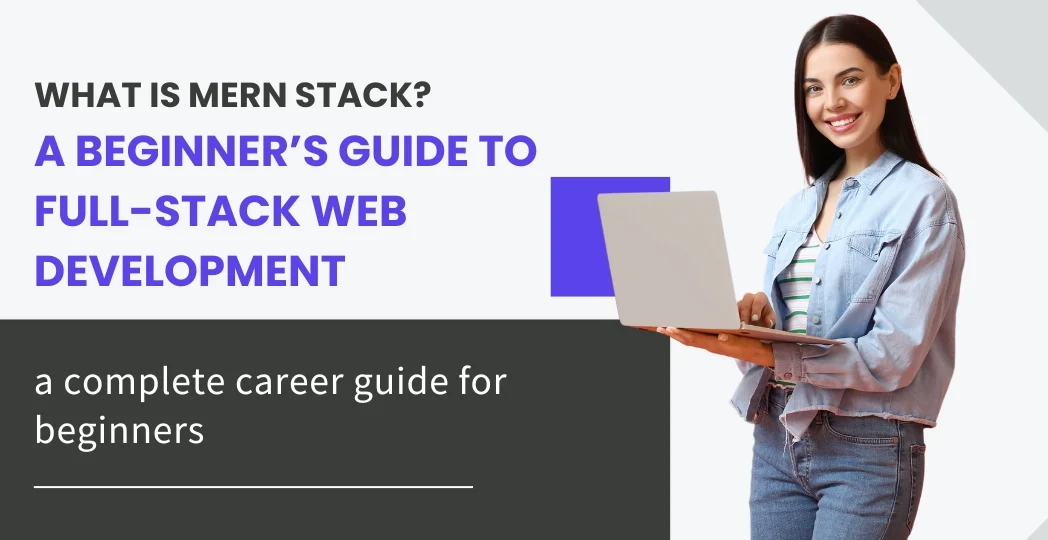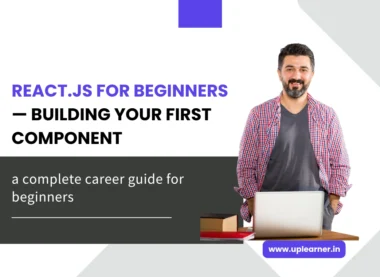Table of Contents
If you’ve ever wondered how modern websites and apps are built—from the front-end that users interact with to the backend that runs behind the scenes—this blog is for you. In today’s world, companies want web developers who can handle both the front and back parts of a website. This is called Full-Stack Web Development. One of the most popular tools used for this is the MERN Stack.
In this blog, we’ll explain what the MERN Stack is, why it’s popular, how it works, and how you can start using it. We’ll keep the language simple, friendly, and clear so that even beginners can understand everything without confusion.
What is the MERN Stack?
The MERN Stack is a group of four powerful tools used to build full web applications. The word MERN stands for:
- M: MongoDB – A database where your data is stored.
- E: Express.js – A web framework that helps manage server-side logic.
- R: React – A front-end library that helps build user interfaces.
- N: Node.js – A runtime environment that lets you run JavaScript on the server side.
Together, these tools create a complete system where developers can write code for both the front end (what users see) and the back end (how things work behind the scenes) using just JavaScript. This makes MERN Stack Web Development easier and faster.
Why is MERN Stack Popular?
The MERN Stack has become very popular among web developers. One big reason is that you only need to learn one language: JavaScript. Since all four tools in the stack use JavaScript, developers don’t have to switch between different programming languages.
Here are some other reasons why MERN is so well-liked:
- Free and open-source: All tools in the MERN Stack are free to use.
- Strong community: Thousands of developers around the world use the MERN Stack, so there’s lots of support online.
- Scalable: The MERN Stack can be used to build simple apps or large, complex platforms.
- Fast development: Using one language throughout the stack means you can build apps more quickly and with fewer errors.
This is why many startups and big companies choose MERN Stack Web Development to create powerful, modern websites and apps.
How Does the MERN Stack Work?
Let’s break it down step by step so you can understand how all the parts of the MERN Stack work together in Full-Stack Web Development.
1. MongoDB (Database)
MongoDB is where your app’s data lives. Whether it’s user information, messages, products, or orders—it’s all stored in MongoDB. This database stores data in a format similar to JSON, which is easy to read and work with.
2. Express.js (Web Server Framework)
Express is used on the server side. It helps handle tasks like setting up routes, managing requests, and connecting to MongoDB. It makes the backend code cleaner and easier to manage.
3. React (Frontend Library)
React is used to build the user interface—the part of the website that users interact with. It lets developers create reusable components, which helps save time and keep things organized.
4. Node.js (JavaScript Runtime)
Node.js runs the JavaScript code outside the browser, allowing developers to use JavaScript for backend logic. It connects everything together and runs the server.
So, when a user does something on a website (like clicking a button), React sends the action to Express, which talks to MongoDB, gets the needed data, and sends it back to React to show to the user.
A Simple Example of MERN Stack in Action
Let’s say you’re building a to-do list app using the MERN Stack.
- The user types a task into the website (React).
- That task is sent to the server (Express).
- The server saves it in the database (MongoDB).
- When the user refreshes the page, the server pulls the task list from the database and sends it to the front end.
- The front end shows the list again (React).
All this happens smoothly using only JavaScript!
How to Start Learning MERN Stack
Starting with MERN Stack Web Development can seem difficult at first, but it becomes easier when you follow the right steps:
- Learn the basics of HTML, CSS, and JavaScript: These are the building blocks of all websites.
- Get comfortable with React: Learn how to build components and manage states.
- Learn Node.js and Express: Understand how to create routes and APIs.
- Start using MongoDB: Learn how to store and retrieve data using Mongoose (a library for MongoDB).
- Build simple projects: Try making a to-do list, notes app, or blog.
- Practice connecting all the parts: Make your front end talk to your backend and database.
With regular practice, you’ll become confident in using the MERN Stack for real-world projects.
Benefits of Using MERN Stack for Developers
- One Language, Many Uses: You don’t need to learn multiple languages. JavaScript does it all.
- High demand in job markets: Many companies are hiring MERN Stack developers.
- Create real, full applications: From front to back, you’ll be in control of the whole project.
- Easier debugging and testing: Since everything is written in JavaScript, you can quickly find and fix problems.
Whether you are a beginner or planning to become a professional web developer, learning the MERN Stack is a smart choice.
Final Thoughts
The MERN Stack is one of the best ways to get into Full-Stack Web Development. It’s powerful, flexible, and uses only one language—JavaScript—making it easier for beginners to learn and grow. By understanding how MongoDB, Express, React, and Node.js work together, you can build complete and functional web apps that users will love.
If you’re someone who wants to learn web development and become a full-stack developer, MERN Stack Web Development can open up many opportunities for you. Start small, stay consistent, and keep learning—soon, you’ll be building amazing apps on your own.







